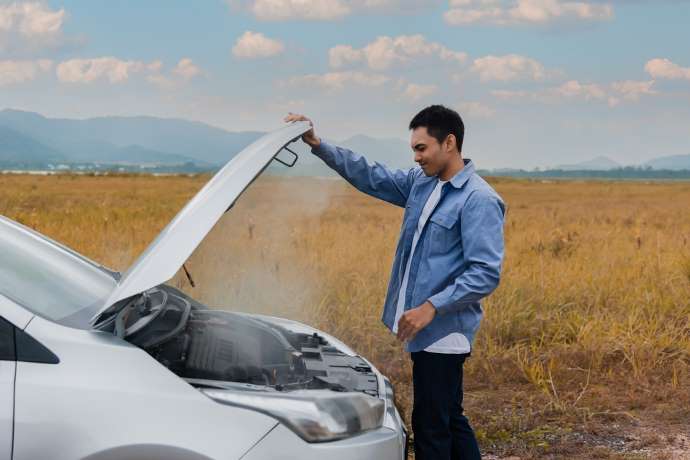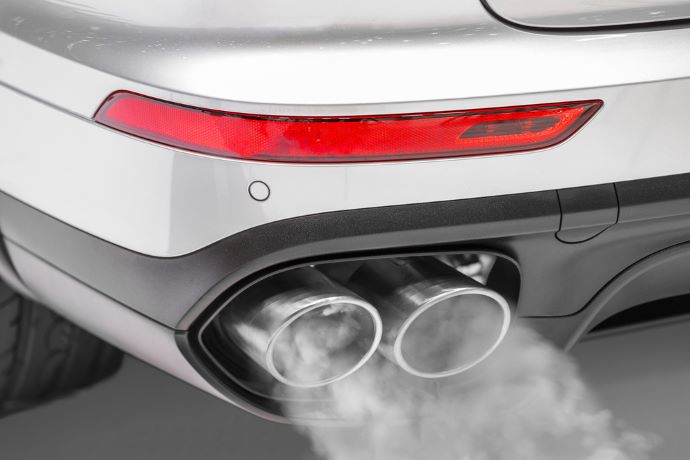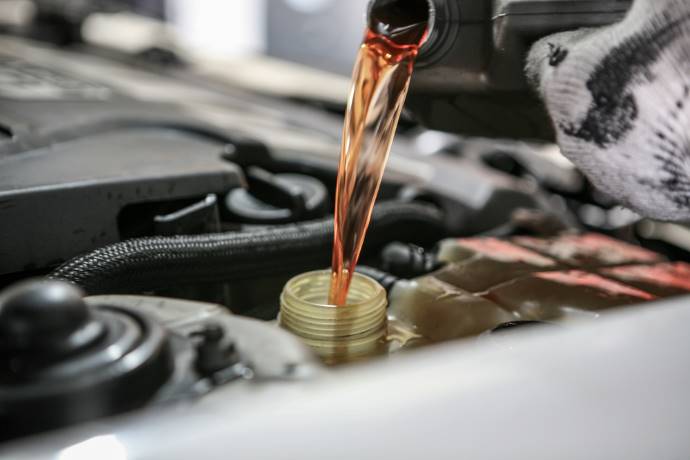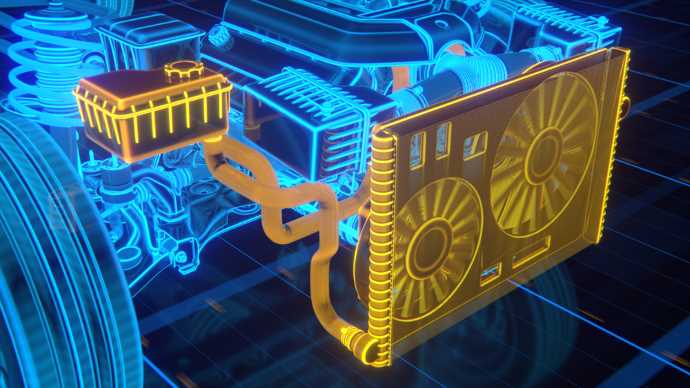The cooling system is a critical part of your vehicle that regulates the temperature and keeps it cool.
If the cooling system is malfunctioning, it can lead to engine overheating and damage.
If you know the symptoms of a failing cooling system, you can take the necessary steps early and save a lot of money.
Therefore, it’s very important to learn about the signs of a failing cooling system and how to fix it.
07 Signs to Know for Car Cooling System Repair
Five major and three minor signs indicate the cooling system needs to be repaired.
Overheating or the temperature gauge going up, a low coolant level, a steaming hood, white smoke coming out of the exhaust, and coolant leaks are all major signs of a faulty cooling system.
While poor engine performance, strange noises, and dirty coolant are minor symptoms of a faulty cooling system,
Let’s discuss these major and minor signs separately.
Major Signs of a Faulty Cooling System
01. Overheating

The most common symptom of a faulty cooling system is overheating.
The temperature gauge on the vehicle’s dashboard rises when the engine is overheated.
The rising temperature gauge indicates that the cooling system is malfunctioning and requires repair.
02. Low Coolant Level
If the coolant level is low during routine maintenance, there are two possibilities: leaks or burning coolant.
The coolant level drops whenever the coolant burns in the engine, or there is a leak in the cooling system.
As a result, it causes the engine to overheat and reduces the car’s overall performance.
03. White Smoke from the Exhaust

White smoke from the exhaust indicates coolant leaks.
If white smoke is coming out of the exhaust, check the cooling system of the car right away.
Please solve the problem before it gets worse.
04. Steaming Hood
White smoke from the hood is another sign that the cooling system is malfunctioning.
If you see smoke coming from the hood, stop driving immediately.
It is unsafe to drive in these conditions.
Open the hood and check what is causing the problem.
Even while driving on the highway, if you notice smoke coming out of the hood, you should pull over on the side of the road and identify the issue.
Pulling over on the roadside isn’t illegal and can prevent a dangerous situation.
05. Coolant Leaks

One of the most common signs is the presence of visible coolant leaks.
It reduces the cooling system’s overall performance and leads to engine overheating.
So, if you find coolant leaks, you must repair your cooling system.
03 Minor Signs of a Faulty Cooling System
01. Engine Performance Decrease
A faulty cooling system causes several problems.
Decreased engine performance is one of them.
A faulty cooling system causes the engine to overheat, work harder, and reduce fuel economy.
However, some other problems also reduce engine performance.
02. Strange Noises
If the engine makes strange noises, it’s time to check the cooling system.
A malfunctioning radiator, water pump, or thermostat may cause noise.
Take this seriously before the problem becomes major.
03. Contaminated Coolant

During routine maintenance, if you find the coolant is dirty or contaminated, change it.
Dirty or contaminated coolant is an early sign of a malfunctioning cooling system that may need repair.
Dirty coolant damages the engine and cooling system.
How do Car Cooling Systems Work
The car’s cooling system maintains the engine’s operating temperature within a safe range.
Different parts of a car’s cooling system work together to keep the engine from getting too hot.
Generally, cooling systems consist of the following 07 components:
01. Water Pump
The water pump is a significant part of the cooling system.
The water pump circulates coolant through the engine and absorbs heat from the cylinder head and engine block.
Later, it passes the heat to the radiator.
Without a water pump, it is not possible to circulate coolant.
Note that coolant, or antifreeze, is a mixture of ethylene glycol and water that prevents corrosion and freezing at low temperatures.
02. Radiator
The radiator is another vital part of the cooling system.
The radiator works as a heat exchanger.
The radiator uses tubes and metal fins to cool hot coolant and transfer it to the engine.
03. Thermostat
The thermostat is a cooling system valve that controls coolant circulation.
The thermostat opens or closes based on the temperature and separates the engine from the radiator.
04. Cooling Fan
The cooling fan circulates cool air over the radiator and engine.
Modern cars have electrical cooling fans controlled by the Electronic Control Unit (ECU).
05. Heater Core
The heater core is one kind of small radiator.
It radiates heat from the hot coolant to the car’s cabin and keeps it warm.
06. Overflow Tank
The overflow tank contains coolant and provides extra space for it when hot coolant expands.
It protects the cooling system from coolant leaks by providing space.
The overflow tank is also known as an expansion tank.
07. Hoses
Hoses are part of the cooling system.
The cooling system hoses are used for coolant flow and vibration absorption.
Car Cooling System Repair Cost
The cooling system contains many components.
So the cost of fixing the cooling system varies.
If the problem is coolant leaks, it costs around $50 to $100 to fix the leaks.
If the coolant is contaminated, changing the coolant or antifreeze will cost around $100 to $250, depending on the vehicle’s coolant tank capacity.
If there are problems with the other part, fixing costs will increase.
What to Do When Engine Cooling System Light Comes On
Ensure regular maintenance to keep your cooling system healthy and well-performing.
If your cooling system lights come on, follow these 10 steps to turn it off:
- Stop your car in a safe place.
- Turn off the engine and open the hood.
- Allow your engine to cool down.
- Once the engine cools down, visually check the water pump, radiator, thermostat, cooling fan, and hoses.
- If any part seems to be faulty, replace it.
- Visually check whether the coolant is leaking or not.
- If there is a leak, fix it.
- If all seems okay, check the coolant level and quality.
- Change the coolant if it is dirty or add coolant if it is less than required.
- In the event of major damage to the cooling system, take your car to a certified repair shop.
FAQs
What happens if the cooling system fails?
If the cooling system fails, you may face the following problems:
- Check engine light comes on
- Engine overheating
- The performance of the vehicle decreases.
- Sometimes the engine shuts down.
What should I look for when inspecting a cooling system?
When you are inspecting a cooling system, look at the following things:
- Radiator
- Is corrosion or rust clogging the system or not?
- Fan belts
- Water pump leakage or damage
- Is the fan-drive clutch working correctly or not?
- Coolant level
- Coolant condition
- Check whether the radiator’s airflow is working properly.
How much does a coolant leak test cost?
Testing the coolant in a repair shop will cost around $30 to $60.
But the price range will be a little different depending on the type of car and the service provider’s location.
Final Thoughts
The cooling system is an important part of a car, so knowing how it works is important.
It will help your car run smoothly and keep the engine from getting worse.
Now you know when a cooling system needs repair.
So, ensure regular maintenance to keep your vehicle’s cooling system healthy.
If your car has any of the above cooling system problems, you should take it to a repair shop.


